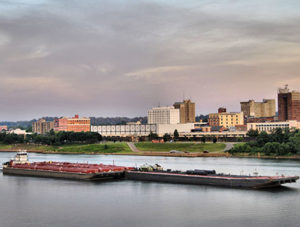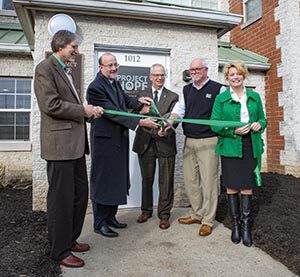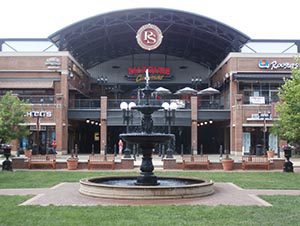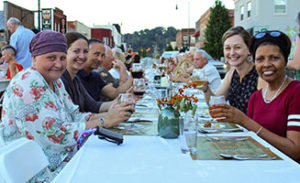Recovery, Revitalization and Renaissance
By Samantha Cart

In the afterward of his popular 2015 book “Dreamland: The True Tale of America’s Opiate Epidemic,” Sam Quinones ponders the decline of community as a predecessor to the drug epidemic in America.
“We wound up dangerously separate from each other—whether in poverty or affluence,” he writes. “Kids no longer play in the street. Parks are underused. Dreamland lies buried beneath a strip mall. Why then do we wonder that heroin is everywhere? In our isolation, heroin thrives; that’s its natural habitat. A life that finds opioids turns away from family and community and devotes itself entirely to self-gratification by buying and consuming one product—the drug that makes being alone not just all right, but preferable. I believe more strongly than ever that the antidote to heroin is community.”
It is this same belief in the importance and transformative power of community that has taken root in Huntington, WV, which has in the past been labeled the drug overdose capital of America.
“What I have learned in my life is when I focus just on me, I start to die inside,” says Huntington Mayor Steve Williams. “But things change when you start to focus on others and how you are able to improve other people’s lives. My vision for Huntington is to show we can overcome by joining together and everyone taking ownership of our problems. My expectation is that what is defining Huntington will begin to define West Virginia and in turn define Appalachia. Then the folks of Appalachia will look at us and say, ‘If they can do it, we can do it.’ What I want us to do in Huntington is set a standard the rest of the nation seeks to emulate—and it’s happening.”
From becoming a model for recovery to being named America’s Best Community (ABC), the city dubbed by the media as ground zero for the nation’s drug epidemic is making a significant comeback. The secret to its success? Collaboration. Across neighborhoods and socioeconomic groups and industries—public and private, for-profit and nonprofit—the people of Huntington are working together to create change and spur recovery, revitalization and renaissance in the Jewel City.
Recovery

On August 15, 2016, 28 people in Cabell County overdosed on heroin mixed with fentanyl and carfentanil. While this may have just been another day for residents entrenched in the height of the opioid epidemic, the story gained national attention and put Huntington on the map as the epidemic’s ground zero.
However, what one might not hear on a national news network or read in a national newspaper is that Huntington is wielding community as its primary weapon in becoming not the epicenter of addiction but the epicenter of solutions.
“I am looking at a city that has been named the most obese, the unhappiest, the most drug riddled and the unhealthiest, but what I see are people fighting and finding recovery,” says Williams, who was elected mayor of Huntington in 2012. “We took our university, our medical and pharmacy schools and our community members and trained them, and now we see them playing an active role in fighting addiction. I created the Office of Drug Control Policy here and invited others to join me. Then the churches wanted to be involved, then businesses, then school systems. Everything has a common thread of ownership in the community. They say success has a thousand parents, so that means we have tens of thousands of parents who are owning their problems and accomplishments in Huntington. There was a hopelessness not too long ago, but now there is a hopefulness.”
In 2017, at the height of the drug epidemic in Cabell County, 1,831 people overdosed, resulting in 132 deaths. While the numbers were gut-wrenching, during this time the citizens of Huntington were busy creating new programs, opening new treatment facilities, volunteering in adult drug court and working together to help their neighbors, families and friends struggling with substance use disorder. In 2018, Cabell County Emergency Medical Services (EMS) reported 1,089 overdoses—a 41 percent decrease.
This impressive percent decrease is significant primarily because Cabell County was experiencing an epidemic level of overdoses, and it cannot be denied that the community was at work making a difference with its range of programs, treatment options and initiatives all aimed at treating the causes and effects of substance use disorder.
One of these life-changing programs is Huntington’s quick response team, or QRT, which is made up of law enforcement and health care and treatment professionals who visit people within 72 hours of an overdose to offer encouragement and treatment options. Coordinated by Cabell County EMS, the QRT made its first visit in December 2017. In 2018, one-third of overdose patients visited by the QRT entered treatment.
“The QRT is starting a rapport with those suffering from substance use disorder and those who have overdosed,” says Huntington Fire Chief Jan Rader. “They’re keeping in touch with them and providing a positive pathway for them to get help when they are ready.”
The QRT often refers patients to another vital program, the Provider Response Organization for Addiction Care & Treatment, or PROACT. A 501(c)(3) single-access hub for comprehensive assessment, education, intervention and treatment solutions, PROACT was established by Cabell Huntington Hospital (CHH), Marshall Health, St. Mary’s Medical Center and Valley Health Systems as an outpatient medical facility that brings together behavioral, social and medical resources from the community to triage patients. It is the only referral point in the region for patients discharged from local emergency rooms or inpatient detox units or visited by the QRT. Substance use disorder patients can see a physician and receive a treatment plan, clinical assessment, medication assisted treatment, peer recovery support and individual or group therapy as well as access to intensive outpatient services, job readiness training and job placement assistance.
Marshall University also plays a major role in the city’s—and the state’s—fight against addiction. The Division of Addiction Sciences at the Joan C. Edwards School of Medicine works tirelessly to find effective and practical solutions to this crisis.
“The Huntington community has proven to be quite unique in its capacity to come together with a common vision of addressing this crisis and, as a result, has become a national leader in the efforts to solve this countrywide problem,” says Stephen Petrany, M.D., chair of the Department of Family and Community Health at the school of medicine and interim leader of the addiction services division. “Marshall’s Division of Addiction Sciences has been able to bring in millions of dollars in grant funding to initiate and support many projects and programs that are beginning to make a difference. We have seen lives saved and lives renewed as a result of our shared efforts.”
Marshall’s medical, pharmacy and social work students also play an important volunteer role in the Cabell-Huntington Health Department’s harm reduction program, providing naloxone training and assistance with the syringe exchange program and helping clients find housing, recovery coaches and treatment options. Cabell County’s fatal overdose numbers in 2017 weren’t nearly as high as its non-fatal overdose numbers due to the significant work of this program.
“We’ve saved lives with the awareness and intervention we’ve put in place,” says Michael Kilkenny, M.D., physician director of the Cabell-Huntington Health Department. “In 2018, we began to see an actual reduction in the number of incidents and feel for the first time that we have made a difference, the interventions are working and the situation is getting better.” One of the reasons Huntington has been able to transform into an epicenter for solutions is the collaboration between government, law enforcement, emergency services, education and health care leaders. A particularly unique partnership exists between the city’s fire and police departments and the Cabell-Huntington Health Department.
“Both the police and fire departments were involved in the health department’s harm reduction program from day one and have a say in what goes on,” says Rader. “If there are any changes in the harm reduction program that cause us issues, we ask for a meeting and talk about it. We need to stop the spread of hepatitis and HIV and prevent outbreaks, but we also need to keep our first responders safe, give them a voice and share concerns. Open communication is key.”
These programs and initiatives have inspired visits from national leaders in health and policy, including Sir Kim Darroch, British ambassador to the U.S.; Dr. Robert Redfield, director of the Centers for Disease Control and Prevention; First Lady Melania Trump; and U.S. Surgeon General Dr. Jerome Adams. Adams and Redfield both spoke at the 2018 Regional Health Summit at St. Mary’s Conference Center, and Adams praised Huntington’s comprehensive plan as a guide that should be emulated by the rest of the country.
“I’m very proud to be from Huntington and to be a West Virginian because I think we’re resilient,” says Rader. “I’m grateful for what we have done as a community and what we’ve been able to accomplish. I think it speaks volumes about the caliber of people who live here. We want to keep the momentum going—we still have so much work to do.”
Revitalization

The sense of acceptance and community that is driving Huntington’s recovery efforts easily lends itself to creative placemaking and rebranding. Huntington is not just a place for those in recovery to seek shelter from the storm but a city committed to inclusivity where everyone is welcome and encouraged to make it a destination—or even a home. The sense of openness can be seen and felt throughout the city, especially in the bustling downtown where revitalization efforts have transformed vacant storefronts and empty buildings into a diverse collection of shops, restaurants and entertainment establishments.
According to the West Virginia Secretary of State’s Office, 464 new businesses opened in Cabell County in 2018, a 7.5 percent increase. While the City of Huntington’s three primary sources of business revenue—business and occupation taxes, sales tax and city service fees—generated $27.1 million in fiscal year (FY) 2016 and $27.9 million in the last FY, it is currently on pace to surpass $28.3 million in the current FY, demonstrating continued growth.
Huntington’s hub of independently owned shops and restaurants has created spaces for people to connect, socialize or conduct business and is driving people to spend more time downtown. Developing a unique restaurant culture not only serves as a tourism hook for Huntington but an advantage for other industries as well.
“As a chamber, we are cutting more ribbons now,” says Bill Bissett, president and CEO of the Huntington Regional Chamber of Commerce. “Commerce tends to happen over a meal, over a drink, over dinner. Having that muscle of a very strong restaurant culture helps us with economic development.”
The uptick in the number of small, locally owned businesses has renewed interest in living and working downtown, particularly for young people. While this transition has opened doors for renovation and remodeling opportunities in housing, it has also spurred the renovation of office spaces and professional buildings.
“Buildings downtown quickly move from empty storefronts to viable spaces for business,” says Bissett. “We see some of these wonderful older buildings become new modern offices while still retaining that original character. Remodeling a building is a risk but a risk that is taken by someone who believes in the reward, the long-term commitment and the city. Younger leadership in our business community is borrowing money, taking risks and believing there is long-term opportunity here.”
Margaret Mary Layne, CEO of Layne Consulting LLC and former Huntington city planner, says she first started noticing this exciting energy about a decade ago.
“About 10 years ago, there began to be a new energy in Huntington that was pretty exciting to me as a Baby Boomer,” she says. “I saw young people stepping up, identifying things they wanted to work on and getting involved.”
Layne believes the most exciting attribute of the young people assuming leadership and moving into downtown Huntington is their interest in the social well-being of the community. “We are in a huge time of transition, and we have this group of people coming up that seems to be working for something that is not just money,” she says. “They want to work for something that makes their community better.”
Many of these young people are products of Marshall University, an undeniable economic driver for Huntington. The university’s new pharmacy school building and graduate student housing complex are under construction on the Joan C. Edwards School of Medicine campus near CHH, which will be a significant enhancement to the Fairfield community. The academic building will be three floors and include state-of-the-art studio classrooms, and the complementary graduate student housing will be four floors with 200 units.
“These new buildings will provide a fantastic environment for learning, living and service right next to an already existing center of contemporary patient care,” says Gayle Brazeau, Ph.D., dean of the pharmacy school. “Our students and faculty will be able to work more closely with the Fairfield community through cultural and educational events, and the addition of more students and faculty and staff members will support current and new businesses in the area.”
While Marshall has always been an economic engine for the region, Bissett believes there has been a more concerted effort under President Jerome Gilbert’s administration.
“Not every region has a Division I university in its backyard,” says Bissett. “Under the leadership of President Gilbert and his staff, we’re seeing a much bigger focus on being a business incubator and a thought leader in entrepreneurship.”
The visual reminders of revitalization in Huntington are everywhere with the renovation of the Big Sandy Superstore Arena; Hal Greer Boulevard gateway project; demolition of houses and clearing of land for redevelopment by the Huntington Housing Authority; upcoming construction of Marshall’s new Brad D. Smith School of Business; and the introduction of CoWorks, a new nonprofit co-working space located on the first floor of the Chase Bank building.
Everyone in Huntington seems to have a stake in the success of their city, including the city itself. Various city agencies have invested time and resources into cleaning and building up their neighborhoods. For example, in late 2018, the Huntington Municipal Development Authority purchased the Flint Group Pigments property on 5th Avenue, eight acres of former warehouse and parking lot space that will be cleared and redeveloped, spurring additional economic growth.
“When you have river, rail and highway right next to a university, all of that can be channeled for redevelopment and transformation,” says Williams. “The next few years are going to be very exciting.”
Renaissance

“I will correct individuals when they say Huntington is on the verge of a renaissance,” says Williams. “They couldn’t be more wrong. Huntington is in the midst of a renaissance.”
One element of that renaissance has been the renewed interest in Huntington’s reputation and narrative. A true collaboration, Marshall University, the City of Huntington, the ABC implementation team and several downtown business owners had all been working on their own campaigns to highlight the city’s positive attributes when they decided to pool their resources and work together to develop a platform for sharing stories and experiences. The final product, the My Huntington movement, was unveiled in July 2018.
“We developed a path for all of these stories to be told using a single statement that truly punctuates all of them—‘This is #MyHuntington,’” says Sara Payne Scarbro, associate vice president for external engagement for the Marshall University Research Corporation and member of the My Huntington committee. “Our goals are simple and pure. We want to empower others—residents and visitors alike—to recognize all of Huntington’s strengths and share what they appreciate about this special community by submitting their My Huntington story for our website and using #MyHuntington in their everyday social media posts about enjoying life in the city.”
Funded by the Foundation for the Tri-State Community, My Huntington has had a remarkable response. Not only has the hashtag been used more than 13,000 times across social media since July, but the initiative also has a large group of volunteers who serve on the advisory committee and meet every three weeks to discuss community projects, upcoming events and future My Huntington profiles and stories.
My Huntington creative partners include Bulldog Creative, Bullseye Total Media and Ann Green Communications, and spots for the movement have appeared across a variety of platforms, including TV, radio, social media and newspapers, encouraging natives and guests to share stories about Huntington’s innovation, economic development, beauty, opportunity, sense of community and kindness.
“It comes back to taking ownership,” says Williams. “The brilliance of My Huntington is that it is a way for folks to brag about the town and say, ‘This is why I love my city.’ There is a strategy involved to let the rest of the state and the region know what is happening here. It eats at me to my core when people take shots at what we are doing here. With the opioid epidemic, we started seeing backlash on social media. People would see the news on the overdoses and say, ‘Let them die.’ I know my town, and that is not the heart of the people here. My Huntington is a loving, caring community that says, ‘We are never going to let go.’”
Citizens can get involved with My Huntington by simply posting a photo on Facebook or submitting a more detailed testimonial for the website.
“There is no right or wrong way to tell your story,” says Scarbro. “The My Huntington committee does not own this movement—the people do. Visitors and individuals living or working in the city are the ones who are writing the complete My Huntington story, like the chefs creating new dishes at the many tasty restaurants, the families getting second chances with nationally recognized addiction and recovery assistance, the numerous volunteers helping those less fortunate, the business owners providing top-notch shopping experiences and the faith leaders leading by example and showing us what can be accomplished when we care. This is My Huntington—a city of innovation, determination, higher learning, excitement, compassion and openness.”
Scarbro believes My Huntington’s success comes from the idea that when people start working together, there is no limit to what they can achieve, and she thinks other communities can learn from Huntington’s experiences.
“Huntington is no different than other city in West Virginia or across our nation,” she says. “We all face challenges, but what makes Huntington so special is that we are developing innovative solutions to our problems. We are not only owning our challenges—we are solving them too. Our crime rate and overdose rate are rapidly decreasing, and there is an uptick in our local economy. These are great stories to share because many other communities are not currently experiencing this. In many ways, Huntington and its people are trailblazers for our state and nation, and others can learn so much from this city.”
It is because of the special bond the people of Huntington share that this renaissance has come about. Those affected by substance use disorder, those who have lost jobs due to a struggling economy, those who felt trapped in a dilapidated neighborhood—they have come together, supported by city leadership, to make a change.
“The people in this town take very seriously the commandant to love each other,” says Williams. “Our city is special because it has special people. I moved to Huntington when I was 16 years old, and I knew then there was something special here. That is why I am so honored that one day I will be able to walk away and say I was the mayor of this city. It is the greatest accomplishment I could ever have.”








